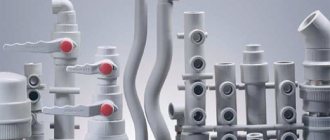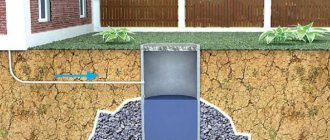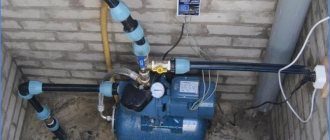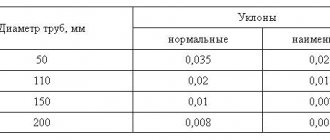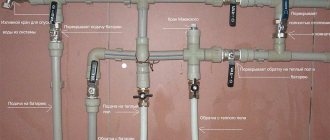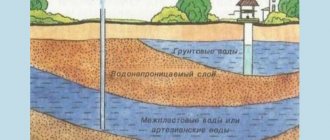Water supply to a private house: external water supply
The entire water supply system located outside the house is called external water supply. The plumbing inside the house is called internal. Internal and external water supply systems have their own characteristics and installation methods. Since winter external water supply is all-season, and the technology of its construction is more complex, we will pay special attention to it.
The external water supply of a private house delivers water from the water supply source to the house, or rather, to the point of water supply entry into the house. Sometimes water is delivered from the source to the house using a hose deployed around the area. This method is not even slightly stationary, so we will not consider it.
Any stationary external water supply (summer and winter) is laid in the ground. For summer water supply, a trench is dug up to 50 cm deep. For winter water supply, the depth of the water pipe should be 50 cm below the soil freezing level, and each region has its own freezing depth.
Copper pipes
Copper water supply is the most expensive, but also the most reliable and stylish solution to the problem of water supply to a country house. Of course, burying expensive metal in the ground when there are more affordable plastic analogues is very wasteful and unwise. But for internal wiring this material can be considered ideal. Its advantages are numerous and undeniable.
- The antibacterial properties of copper do not allow pathogenic bacteria to develop in water.
- The durability of copper alloy pipes is the highest, and they do not require repairs for decades.
- This metal is easy to process due to its ductility and low hardness.
- It is not subject to corrosion; upon contact with water, only a thin layer of metal can oxidize, and the resulting oxide film creates additional protection from mechanical and chemical influences.
- The lumen of the pipes is not overgrown with deposits.
- The metal looks very noble and does not require paint coating.
Copper pipes fit perfectly into a retro-style interior, where plastic would look out of place Source handicraftgirl.com
However, installing a copper water supply is not so easy; only an experienced craftsman can do this.
Trench for external water supply for year-round use
- In central Russia, the depth of soil freezing is 1000-1200 mm, which means that a winter water supply trench will have to be dug 1600-1800 mm deep.
- A classic trench should have a cross-section in the form of an inverted trapezoid, with the base of the trapezoid at ground levels.
- If you use HDPE (low-density polyethylene) pipe for external water supply, then the evenness of the trench does not matter and it is quite possible, if the landscape so requires, to make a trench with a bend.
Construction of a trench for the external water supply of a house
Read more about the construction of trenches for water supply in the article Laying a trench for the external water supply of a private house. Briefly here: At the bottom of the trench you need to make a sand cushion of 10-20 cm. For clay soil, make a cushion of gravel (crushed stone) under the sand.
Standard solutions
There are recommendations:
- usual pipeline diameter is 10 and 15 mm;
- the riser will require a little more - 25.
You need to know: the purchased products are not created by jewelers, and “10 mm” pipes will easily turn out to be a couple of millimeters larger. Be sure to be guided by such a parameter as the thickness of the walls: you need to choose the diameter exactly inside (for this you need to subtract the wall thickness from the total) so that all the fittings fit!
The higher the level of complexity of future plumbing work in a household, the larger the diameter of all pipes, both long and short, should be. When a “complex” pipeline with many turning points, joints and expected pressure surges is expected, it is worth insuring yourself by increasing the diameter. You should also definitely take into account the maximum values of both pressure and temperature in your water supply so that it does not burst from the first water hammer.
The savings here are unjustified. Additional advice: in order for the plumbing system to perform flawlessly and be reliable in operation, you need to select high-quality products. This applies to pipes and small elements (fittings and couplings). It would be a shame to “ruin” a proven system with cheap fittings.
Introducing external water supply into the house
There are two ways to introduce water pipes into your home.
- Input of water supply through the foundation. In this case, a hole is drilled in the foundation to insert a water pipe (if such an input is not made in advance when pouring the foundation);
- The entry of water supply into a house on any columnar or pile foundation is carried out between the foundation pillars and is done with insulation of the bend at the entrance to the house.
- Sometimes they install water pipes under the foundation.
Organization of water supply at the dacha
It is possible to organize a water supply at the dacha only using a pump, but it can be supplied in two ways: from a storage tank or from a hydraulic accumulator.
When using a scheme with a storage tank, you have a supply of water equal to the volume of the tank, but the pressure in the system is low. It is created by a difference in heights: the tank is installed at a height - in the attic of a summer house or the roof of an outbuilding. The main condition is that its bottom must be located above any water intake point. Then there will be water in the taps.
The second method, with a hydraulic accumulator, is more convenient in that pressure is created and automatically maintained in the system. If the hydraulic accumulator is supplemented with a pump and automation (pressure switch), the entire assembly is called a pumping station. The trick here lies in the hydraulic accumulator. This is a cylindrical container divided into two parts by an elastic membrane. Gas is pumped into one part under low pressure, and water is supplied to the second by a pump. As it enters, the water compresses the gas more and more, which is why pressure is created in the system (about 2 Atm).
Organization of water supply at the dacha from a well with a hydraulic accumulator
When the tap opens (household appliances turn on or watering starts), water is supplied from the accumulator. The pressure in it gradually decreases. Its value is controlled by special relays. As soon as the lower threshold is reached, the pump turns on, restoring its set value. The highest threshold is monitored by a second sensor, which turns off the pump.
A similar country water supply system can be implemented in both winter and summer versions. The difference is where to install the equipment and how deep to bury the pipes.
Conclusions instead of instructions for installing water supply to the house
Water supply to the house is carried out in stages:
- Mark the route from the water supply source to the water supply entry into the house;
- Dig a trench 50 cm deep above the soil freezing level (about 1500-1800m);
- Make a 20 cm sand cushion at the bottom of the hole;
- Drill a hole in the foundation of the house for the water pipe. Place a sleeve from a piece of steel pipe into the hole;
- Lay an external water supply pipe from an equipped source to the entrance to the house and insert the pipe into the house;
- Insulate the water pipe. The insulation should not come into contact with water. Pay special attention to insulating the place where the pipe exits the well and the exit from the trench into the house (if there is one) and where the pipe passes through the foundation sleeve;
- Connect the external water supply to the source and input (temporarily), and then check it for leaks along the route;
- Cover the external water supply pipe with 20 cm of sand and 30-40 cm of soft soil;
- Without compacting the soil, fill the trench with soil dug out from the trench. Remove boards, roots, and construction waste from the soil.
©Elesant.ru
Other articles of the training course: Water supply at home
- Do-it-yourself water drilling for water supply to a house, cottage, or dacha
- Types and choice of surface pump for a private house
- Choosing polyethylene pipes for external water supply at home
- Choosing a water supply scheme for your home: do-it-yourself water supply for your home
- Choosing a well pump is easy
- Sources of water supply systems for a private home
- How to install a well for a private house
- External and internal water supply of a country house
- Water supply to the house: external water supply of a private house
- Laying a trench for the external water supply of a private house
- Calculation of a surface pump: how to calculate the pressure of a surface pump
- Calculation of a well pump: formula and example of detailed calculation
- Private house water supply systems
- Automatic water supply station: selection and installation of a water supply station
- Insulation of the external water supply of a house: materials and methods of insulation
Low pressure polyethylene pipes
HDPE pipes are used for external laying of water pipes. They are produced in lengths and coils of diameters corresponding to the standard number series.
There are several grades of polyethylene depending on its internal structure; pipes are made from PE-80 and PE-100, the latter being the best.
Unlike polypropylene pipes, the wall thickness of HDPE pipes can vary within wider limits. For them, the dimensional ratio of the outer diameter to the wall thickness SDR is also established, and it can vary in the range from 2.5 to 41.
HDPE pipes are designed to transport water with a temperature not exceeding 40 °C. It is clear that they are used only in cold water supply systems.
As for the pressure characteristics, the pressure that a HDPE pipe can withstand ranges from 2.5 to 25 bar and directly depends on the SDR.
HDPE pipes are connected using external compression couplings, so that their internal diameter remains unchanged throughout the entire pipeline.
Related article:
What is HDPE pipe
A separate article explains what HDPE pipe is - the production process, application, joining methods, installation.
Rice. 4 Installation of polypropylene and polyethylene pipes
Dependence of length and diameter of pipes
In conventional water pipes, the speed of liquid transport is usually about 20 m/s. This indicator has a direct impact on what the cross-section of the water supply pipe will be.
The dependence of the diameter of water pipes on the length of the water main is as follows:
- If the system length is less than 30 m, you should opt for 25 mm pipes;
- Pipelines longer than 30 m must have a diameter of 32 mm;
- For water pipes less than 10 m long, pipes with a diameter of 20 mm are quite suitable.
When installing private water supply networks, pipe sections 4 meters long are most often used, but not always - for example, for laying long pipelines, products about 15 meters long are successfully used.
In order for such long pipes to function without problems throughout the entire life of the system, high-quality connections will be required.
Pipe materials: advantages of plastic
When installing modern water supply systems, plastic pipes are most often used. They have a number of advantages over other materials:
- reliability;
- comfort in use and installation;
- ease.
Recently, metal-plastic and metal pipes are practically not used. This is explained by their high price, as well as much less practicality. In addition, such materials require the use of welding equipment during the installation process.
When organizing a water supply system using plastic pipes, no special knowledge is required. To bring sewage and cold water into the house using them, crimping equipment is sufficient. An ordinary team of builders can work with such materials. Plastic pipes can be hidden in the decoration. The only condition is that in places of possible temperature fluctuations it is necessary to create bends that will prevent breakthroughs in the future.
Maintenance and repair of internal pipelines
Maintenance of hot water and cold water pipelines is carried out based on the material of the pipes. Thus, metal plumbing systems require regular painting to avoid corrosion processes on the external surfaces of the pipes. It also requires periodic replacement or cleaning of filter elements, which can become clogged with iron oxide products and biological components.
All types of polymer pipes used in water supply systems require much less attention during operation. It is enough just to monitor their integrity and eliminate leaks that may arise as a result of insufficiently high-quality installation.
Repair of water supply pipelines usually comes down to replacing damaged sections, inserting new pipes, or, in case of minor damage, soldering/sealing leaks.
Relationship between characteristics
Dimensional characteristics are interrelated. For example, if the pressure in the incoming pipeline increases, then, with a constant cross-section, the pressure in the hydraulic system will become higher, and troubles may begin: connecting fittings will leak, the water supply will become noisy.
How does the length of the water pipe affect the diameter of the pipes?
Standard sizes of pipelines, their diameters are measured in inches. 1 inch is equal to 25.4 mm. The inch is indicated in the literature and on diagrams by the double apostrophe icon - “””. In domestic water supply systems, both houses and apartments use 0.5-inch or 3/4-inch calibers. They are designated as 1/2″ or 3/4″.
Table of pipe diameters for water supply.
The required diameter of the pipe elements is directly proportional to their total length. The diameter of the water supply pipes in the apartment does not exceed 20 mm.
The same section is used in a country private house with a small length, up to 10 m. If the length of the water supply in the building reaches 30 m, you need to take a pipe in a 25 mm crossbar; if the length is longer, then you should choose 32 mm.
The number of connections, turns and water points also affects the recommended diameter upwards. If you incorrectly select the capacity of pipelines for a sufficient number of consumption points, this can lead to the fact that, for example, opening a tap in one room will lead to a decrease in pressure and loss of water in another.
In a private house, the number of water points is greater than in a city apartment. The simultaneous use of most of them can even lead to the inoperability of household appliances, a washing machine or a dishwasher.
When designing and installing the system, it is better to use pipes with a spare cross-section, especially in a private house in the absence of a central water supply. Water risers have a larger diameter than the outlets going from the riser to the points of consumption.
Why does the diameter of the pipes determine the throughput of the water supply system?
According to the laws of hydrodynamics, the same amount of water passes through any section per unit time. With constant pressure and changing cross-sections in pipes, too small a cross-sectional size will lead to constantly high pressure in the system, which will reduce its reliability and can lead to breakdowns. It is inconvenient to use taps with increased pressure in the network.
To correctly calculate the water supply, it is necessary to take into account the throughput of the pipes. It must correspond to the number of consumption points, the amount of water consumed by a particular plumbing fixture. The water tap consumes no more than 5 liters of water per minute.
The table determines the pipe capacity.
When calculating the diameter of pipelines, you need to take into account:
- overall length;
- number of branches;
- number of joints and turns;
- water pressure created by a well pump
For a private country house, there is no point in making precise calculations using complex formulas and computer programs. This calculation is enough.
The water tap consumes no more than 5 liters of water per minute.
Up to 30 l/min can flow through a 25 mm pipe; with a diameter of 32 mm, the throughput increases to 50 l/min. For 10 water points, a 1-inch inlet pipe is sufficient. For greater accuracy, you can refer to the Shevelev tables. Another general rule: larger diameter - lower pressure.
The material from which the pipes are made affects the choice of their dimensional characteristics. To supply water to a home, pipes made of polymers can be used: plastic, PVC, metal-plastic, polyethylene. It is possible to create a water supply system made of steel, stainless steel or copper.
Autonomous water supply in the country
Since in rural areas there are often power outages, and any pump can only work if there is electricity, it would be a good idea to have a reserve supply of water in case of a power outage. This may be a container installed in the attic or in a separate area. Water can be pumped into it using a submersible pump from a well, well, or river. And the pumping station will “pull” water from this tank.
Autonomous water supply system from a tank. Approximate diagram with a reserve water supply in the tank
Plumbing at the dacha from a tank is convenient because it can also collect rainwater, but you need a good filter system: first coarse filters, then several fine filters. And be sure to also install a filter and a check valve at the inlet of the suction pipeline from the pumping station. The filter is for insurance - the equipment is demanding on water quality, and the valve is so that when the pump is turned off, the water is not dumped back.
The presence of a tank in the water supply system of a dacha is also good for plants: in the summer, if it is installed outside, the water will heat up. It is known that plants watered with warm water grow more actively and bear fruit better.
If desired, you can organize drip irrigation - assemble a pipeline from pipes, insert tees in the right places, to which you connect hoses for drip irrigation.
A drip irrigation system can be organized even when you are making water supply at your dacha with your own hands
Here's what it looks like schematically. Raise the tank to a height of at least 1 meter. You pump water into it from a well, a well, or a river. Its level is controlled by a float mechanism (like those found in waste tanks). From the bottom of the tank there is distribution to the beds. First there is a solid water pipe, and a drip pipe with holes comes off from the tee.
How to make a water supply system in a country house for watering from a barrel
Pumping stations for water supply. When should it be placed?
The question of choosing a pumping station faces those who do not have the opportunity to connect a water supply from a central water supply system. In this case, water will be supplied directly from a well or borehole. The pumping station is capable of raising water to a level of 9 meters. This option is convenient for collecting water from wells and wells.
Pumping units have the advantages of having a special protection mechanism against burnout, as well as a hydraulic accumulator.
Existing materials for creating water supply networks
Before you calculate the diameter of a pipe for a water supply system, you need to select a material for it. It could be:
- metal (steel, copper, cast iron, their various compounds);
- polymeric materials - plastic, polyethylene, metal-plastic, PVC;
- combinations of metal and plastic structures.
Whatever the characteristics of the materials, the dimensions will also be important. In particular, the diameter of plastic pipes for water supply (metal and metal-plastic too) is divided into external and internal, and the permeability of the pipeline depends on it and the thickness of the walls.
The level of working pressure is also influenced by certain characteristics of the material. In particular, steel is characterized by reliability and strength, but is susceptible to corrosion and is also heavy, making installation of the system difficult. Also, limescale may accumulate inside the steel pipeline - consequently, the diameter will decrease and the permeability of the system will decrease.
Plastic is characterized by low weight, simple and easy installation. Such pipes do not accumulate plaque inside and do not rust; they are inexpensive and flexible. If the pipes are plastic, without a metal layer, then they can expand due to heating, but in metal-plastic products this drawback is eliminated.
How to choose the correct size of pipes for water supply?
When introducing water into your home, it is important to choose the correct size of pipes used. If it is too small, several problems may arise:
- water may pass noisily through laid pipes;
- A coating forms inside the pipe, which makes it difficult for water to move through.
When choosing a pipe diameter, experts recommend relying on 2 main indicators: the speed of water movement, as well as the total length of the pipeline. The first parameter is usually standard: water moves at approximately 2 meters per second. The second largely depends on the area of the house and the distance of the plumbing equipment.
So, if the planned length of the pipeline is up to ten meters, it will be enough to use pipes with a diameter of 20mm, 10-30m - 25mm and over 30m - 32mm.
Compliance with all the rules will help you cope with introducing water into the house on your own. However, even if builders will install plumbing into your home, it would be a good idea to consult with plumbers. They will tell you how best to do this and what materials to use for this. It is important to make sewerage and water at a distance of at least half a meter. The pipes bringing water into the house should be made a little higher so that they do not flood into the screed. The sewer can be filled without problems. You may need to connect various devices to the water pipes: a storage tank or a pump. If we take into account all the nuances, then the pipeline, even organized without the involvement of a professional plumber, will last for many years.
